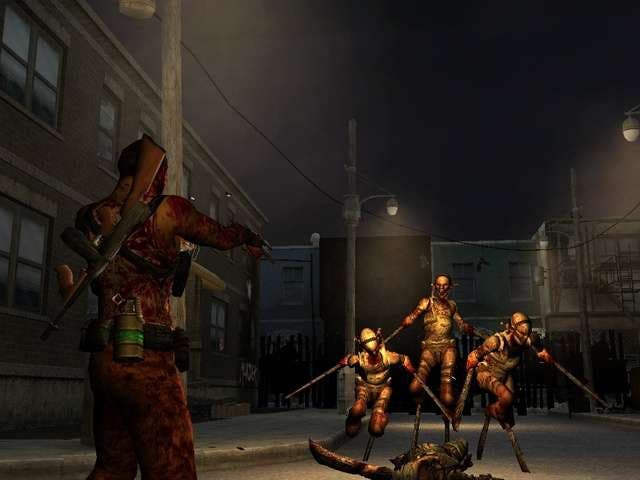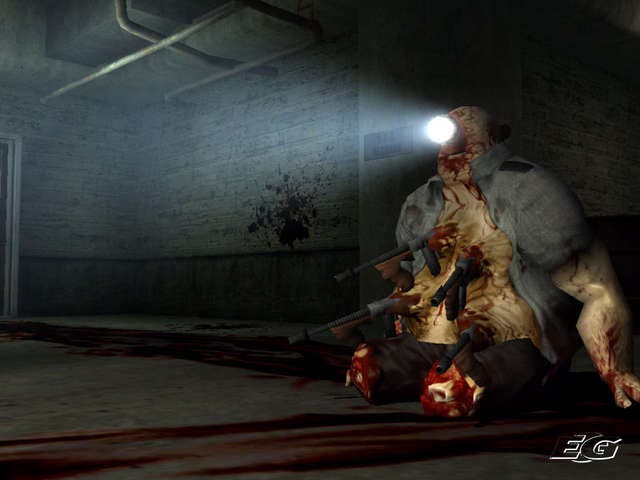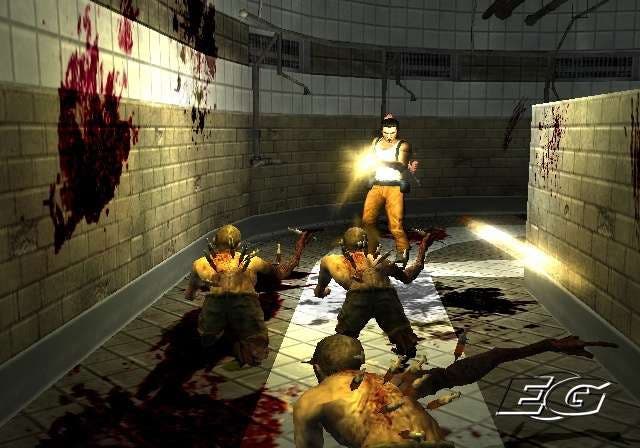The Suffering: Ties That Bind
Torque's back, and he's in a right mood.
Before beginning this article, we thought it might be an idea to dig out our review of the first Suffering game (not written for this website, by the way, but for a long since dead PS2 magazine you'll never have heard of). And not just to see if there were good jokes we could reuse, either - we wanted to make sure that we weren't missing anything, that there wasn't some new element in The Suffering: Ties That Bind that we'd forgotten wasn't in the first game.
It was a fruitless effort, however, and not just because there were no good jokes. We realised that our review of The Suffering could pretty much do for our review of Ties That Bind with only a few amendments and the addition of three key words here and there. That's because this is a sequel which doesn't really move things on much - apart from different environments and some further plot developments, there's not a lot that's new here.
But this isn't about to turn into one of those rants against unoriginal games which begins with a general discussion of the nature of sequels before directing a blast of bile at EA and finishing up with a complaint about how even Miyamoto's at it these days and all the Mario Party games are rubbish.
And that's because we think it's unfair to level a load of negative criticism at a game solely on the grounds that it's unoriginal. Change is often good, yes, but sometimes do we just want more of the same. That's why we order the same pint of lager each time we go down the pub, for example, and why we don't then complain to the barman that it tastes too similar to the pint we had last week.
Besides, mucking about with a formula that works can be a dangerous game. Is there anyone who can say that they honestly prefer Warrior Within to Sands of Time? In fact, is there anyone who can name a game sequel where the character's gone "dark" that's any better than the original? We're bored of it, frankly.
Family problems

Thankfully the hero of The Suffering, Torque, couldn't really get any darker than he already was at the start of the first game - what with him being a death row prisoner convicted of beating his wife to death, drowning one of his sons in the bath and throwing the other one out of the window and all. Not to mention serious rage issues which result in him transforming into a giant homicidal mutant every now and then.
The question is, of course, did he do it? Well, that depends - there were "good", "bad" and "neutral" endings to The Suffering, and the way you played the game determined which one you got to see.
Ties That Bind begins where the "neutral" ending left off (though if you have a completed save game from the original, the game will otherwise start with how you ended it) and sees Torque fleeing Carnate Island and heading towards the city of Baltimore aboard a speedboat. His journey is interrupted by the ghost of his dead wife, who insists that he must return to their old apartment as she has something she needs to show him. And it's pretty clear that she doesn't mean that new set of curtains she's put up in the lounge.
After a brief skirmish with some armed officers and a bunch of scientists who want to work out what makes Torque tick, our anti-hero finds himself let loose on the city streets - time for more grisly flashbacks which explain more about his past life and what really happened to his family.
Time, too, to say hello to some old friends - namely those weird monsters with machetes for limbs, those crazy muthas with syringes sticking out of their backs, those deranged beings who clearly had a nasty experience with an electric chair at some point and so on and so forth.
We liked all those monsters the first time around - being as they were so completely off-the-wall and genuinely scary in some instances - and it's good to see them back, even if the shock value isn't quite so intense. There are new enemies to face off with, too, and they're just as inventively twisted and gloriously grotesque. However, the majority of baddies are familiar faces - those who have faces, anyway - which is a bit of a shame.
Weapons of choice

It would have been nice to have more new weapons to play with, too; you're looking at the same old array of revolvers, pistols, sub-machine guns and flashbang grenades, for the most part. Only a few of them really feel powerful enough to get the job done quickly and satisfyingly, and annoyingly you can only carry two weapons at once - one of the few things that is different from the original game.
We could also have done with a bit more ammo lying around, since we often found ourselves having to resort to melee combat - not the ideal option when you're dealing with a bundle of enemies that have just popped up out of nowhere, or when you're faced with something that has a load of rifles sticking out of its chest.
Still, you can always teach them who's boss by transforming into Torque's mutated alter ego, providing there's enough juice in your Insane Meter. In his hulk-like form Torque can slash and slay away with wild abandon, but unfortunately the effect doesn't last for very long and if you forget to transform back before the meter is empty you lose a bit of health. This seems like a bit of a pointless game mechanic and we could have done with out it, frankly.
As in the first game, your time is split between killing enemies, having flashbacks and working out how to get to where you're supposed to go next. This is rarely very difficult - all that's usually required of you is finding an unlocked door or moving a crate about and so on. There is the odd nice surprise, though . We were genuinely scared when a ladder collapsed after we stepped on the first rung and a particularly terrifying monstrosity appeared from nowhere.
Once again the game has different endings based on the 'moral path' you invisibly choose. For example, you can decide whether to help the civilians you encounter to achieve their own objectives or just pump them full of lead. Since there's no lock-on system and Torque's attacks can often be a bit too sweeping you might find yourself accidentally killing the odd innocent even if you're trying to follow the path of righteousness, however.
Plus points

But we found that it wasn't difficult to overlook such niggles, thanks to all the good things that Ties That Bind has going for it. Environments are diverse, detailed and brilliantly lit, with the same spooky atmosphere that pervaded the prison in the first game. We especially like the abandoned cinema, where you fight off a load of bloodthirsty opponents as your nutty old psychotherapist rattles off a Shakespearean soliloquy in the background. A bit over the top, maybe, but fun all the same.
Enemies are also well designed, with fluid animations and varied attack patterns, and there's often a real sense of horror when you hear a weird noise and realise you're about to be confronted with some entirely new manifestation of gruesomeness.
Best of all, there's loads of blood. It's everywhere. On the floor, on the walls, and increasingly all over Torque's chest and face. Not one for young children, squeamish people or Miami-based lawyers on tireless crusades against violence in videogames, then.
The story is a major plus point, too, as it's genuinely intriguing and very well told. Flashbacks are never too long to seriously interrupt the flow of the game, and there are neat touches such as the phones that ring unexpectedly. Pick up the receiver and you'll doubtless hear the voice of a dead relative - get there too late and you'll never know what you missed. Okay, so said dead relatives never reveal anything particularly crucial [You have experience?! -Ed] and yes, this feature was also present in the first game, but we still found ourselves wanting to rush to the phone and take that call.
It helps that the voice acting is excellent. For example, Caleb Blackmore, a fellow ex-con who has a mysterious connection to the deaths of Torque's family, is played by Michael Clarke Duncan out of The Green Mile, and does a fine job too. Rachel Griffiths (Six Feet Under, Blow and, um, Muriel's Wedding) also appears as Jordan; as in a scientist who's trying to capture Torque and not Peter Andre's lovely new bride, obviously.
If you get really into the story there's plenty of background stuff to be found in the game's Archives section, including descriptions of the monsters, spooky historical tales about the city's darker quarters, and the diary of your dead wife. Nifty.
It's true to say that there's not a lot new here. We'd have liked more crazy new enemies, and a more varied array of weapons, and perhaps even some new gameplay elements to set this title apart from its predecessor a bit more.
But the good news is that they've managed not to mess up any of the things which made the original so enjoyable. The control system is still intuitive, the camera does what it's supposed too, there's a good amount of gory moments and genuine scares and the whole thing has bags of atmosphere. Plus you can add to that a storyline that's gripping enough to make us want to keep on playing.
This isn't a game that's going to raise any bars, push any envelopes or revolutionise any genres, as they say. But if you played and enjoyed the first game and fancy more of the same, The Suffering: Ties That Bind won't disappoint. And even if you've never heard of the first game but are looking for a good, solid action adventure that features a decent plot, well designed gameplay mechanics, a bit of replay value and a nice big dollop of gore, it's well worth checking out.

